
“All our efforts will be for naught unless we Punic soldiers burst through the gates of Rome and I, Hannibal, plant my standard in the heart of the City.”
…..Juvenal (Satire 10)
“The Gates of Rome!” In that poetic phrase there is more history and drama and lore than is to be found in a library of novels and social studies textbooks. And – wondrous to say – the gates still stand, in defiance of the ravages of time and the elements.
They constitute yet one more facet that renders Rome the gem of all the great cities on earth. For Rome alone requires entrance through one of the openings in its ancient walls. One does not hear of “The Gates of Paris,” or “The Gates of Madrid,” or of London, or Tokyo, or Vienna, or Boston.
Baked by the sun of more than 600,000 days, Rome’s gates are especially suggestive in the light of the moon. It is at this hour, when the nightingales are in song, that there come trooping out of the darkness, hosts of memories, ghosts of Imperial Rome: conquering, plume-helmeted legions bearing their spoils of war; foreign merchants vending exotic wares; the apostle Peter – foot weary from having walked up the Appian Road all the way from the Naples area; the barbaric hordes of the Middle Ages, Napoleon and his vaunted armies, General Kappler at the head of his goose stepping Nazis, General Mark Clark at the front of a convoy of his liberating Fifth Army following their bloody victory at nearby Anzio. All passed through … “The Gates of Rome.”
Through these vast portals have walked – or ridden – the likes of Dante, Goethe, Keats, Shelly, Byron, Hawthorne, and Twain; of Da Vinci, Michelangelo, Giotto, Raffaele, Monet, Manet, and Picasso; of Liszt and Tchaikovsky, of Mastroianni and Loren; of Taylor and Burton. Browning used to say: “Sooner or later, everyone comes ‘round to Rome.” And anyone who “comes ‘round to Rome” must, perforce, use its gates, which to the ancient Romans were often rendezvous points: “Let’s meet at the Appian Gate.”
“Nos ad Portam Appiam occurramus”
But before going on about the gates, we must pause here to talk about the lofty, thick walls which they pierced.
The walls of Rome rank high among archaeologists’ favorite antiquities there, transporting the viewer back through time and space to the late empire and beyond. With a little imagination, one can see the defenders of the city hurling fire and missiles down from the heights and through the slots; envision the storming of the gates, and the battering rams; observe the barbaric hordes spilling through and scaling over the fortifications to lay waste to the aged capital.
When he founded Rome in 753 B.C., Romulus’ first public work was to enclose his domain with protective walls built at right angles to form a perfect square around the primitive village on the Palatine Hill and create what was known as Roma Quadrata i.e. “Square Rome.” The Eternal City has ever since been walled in – next by the Servian Walls; finally by the Aurelian Walls.
Romulus’ Quadrata was consecrated to the gods in solicitation of their divine blessing and protection. (Walled-in villages were already commonplace throughout Italy, the Etruscans having imported the practice a century earlier.) One night, Remus, drunk with resentment over his brother’s selection as monarch, defiled the consecrated walls, thereby committing sacrilege and meeting death at the hands of his twin.
The historian Tacitus has this to say: “The walls were erected according to Etruscan rites, marked out by a furrow created with a plough, drawn by a cow and a bull, leaving places necessary for three gates.” From the writer Varro we even learn the names of two of these portals. On the east was the Porta Mugonia, so named for the “mooing” of the cattle which were led out to pasture through it. On the west was the Porta Romulana, named for the founder-king.
From Virgil’s Aeneid, Book VIII, we come upon the name of the third gate:
Vix ea dicta, dehinc, progressus monstrat et aram et Carmentalem Romani nomine portam quam memorant, nymphae priscum Carmentis honorem.
“Then (Evander) having spoken, resumed walking (with Aeneas). They came upon an altar and the Carmenta Gate named in honor of the nymph who prophesied the great fortune of the Romans.”
Remains of Romulus’ immured hamlet, though scanty, are well worthy of a visit to the Palatine, For here truly is the cradle of Western Civilization. Along the vast foundation of Tiberius’ Palace can be seen fragments of those primitive walls’ tufa boulders.
In the reign of the sixth king Servius Tullius (578-535 B.C.), who governed well, the Servian Walls rose in protection of what had become by now the Urbs Septimontium (city of the Seven Hills: The Palatine, Aventine, Capitoline, Esquiline, Quirinal, Viminal, and Caelian.)
Built of immense blocks of volcanic tufa, these fortifications were improved and enlarged on orders of the Senate in the fourth century B.C. They were 35 feet in height, 12 feet thick, and nearly 7 miles long, enclosing an area of more than six hundred acres, and made more formidable by a deep ditch on the outside, and a dirt rampart on the city side.
________________________
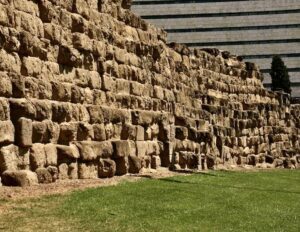
Remains of the Servian Wall in front of Termini Station, Rome, Italy. Roundtheworld at wts wikivoyage, Public Domain, Wikimedia Commons
________________________
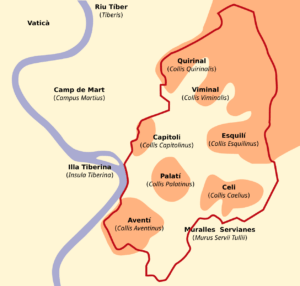
The Servian Wall encircled the seven hills of Rome. http://commons.wikimedia.org/wiki/User:Renata3, CC BY-SA 4.0, Wikimedia Commons
________________________
There were fourteen gates, two of which survive fragmentarily: the Porta Esquilina, and the Porta Capena which opened on to the Appian Way. Stretches of the wall still stand guard in various sections of Rome. One sizable portion remains extending out of the twentieth century railroad terminal, near the Baths of Diocletian. On Viale Aventino we pass through two more great portions where a bronze plaque gives an informative account of the walls’ story. The historians Livy, Strabo, and Dionysisus all mention the Servian Walls.
Many times restored and strengthened, the Servian Walls were abandoned in the Imperial age and therefore many stretches were demolished or utilized for other public works and ultimately replaced by the still wonderfully preserved red-brick Aurelian Walls, which lend such sublime distinction to the city we visit in our time.
With the Pax Romana by then but a memory, the Emperor Aurelian, from A.D. 271 to 275 employed tens of thousands of military troops in the task of walling-in the Imperial Capital in the vain hope of walling-out Rome’s growing list of powerful enemy nations and barbarian tribes.
Anything of consequential size that stood in their path was incorporated right into the ramparts, such as the Pyramid of Gaius Cestius. This monument dates from the first century B.C. and the inscription tells us it was erected in less than a year as a sepulcher for the ashes of Cestius, a high public official who on a junket to Egypt had been so duly impressed with the tombs of the pharaohs. For the statistics devotee we offer the following numbers: The walls ambled around the hills for thirteen or so miles, enclosing approximately 3,500 acres. Soaring to a height of slightly over fifty feet, they had 383 towers, 7,020 battlements, 2,000 windows, more than 5,000 loopholes, and more than a hundred rooms serving as guards’ quarters and latrines.
___________________________

The Aurelian walls between Porta San Sebastiano and Porta Ardeatina (Viale Ardeatina). Lalupa, Public Domain, Wikimedia Commons
___________________________

Map showing the Aurelian Wall (in red). Joris at Dutch Wikipedia, CC BY-SA 4.0 Wikimedia Commons
___________________________
From several elevated vantage points about a mile or so out on the old Appian Way – especially from the summit of the driveway leading to the Catacomb of San Callisto – the walls and one of the massive gates come into view, bringing to the romantic mind “the many-towered Camelot.”
There were eighteen main gates and several smaller openings. Fourteen of the major portals pierce the ramparts at the points where the great consular highways depart from the city. Each such gate was usually called for the road which it launched, e.g. the Porta Appia for the Via Appia, the Porta Ostiense for the Via Ostiense, and so on. The Porta Nomentana, the Porta Latina, the Porta Praenestina, the Porta Tiburtina and numerous others were thus given their names.
At one point the wall is referred to as the Muro Torto (Twisted Wall) near the Piazzale Flaminio. Peculiarly irregular and looking about to fall, it nevertheless slouches on with no help from restoration efforts. An old legend has it that St. Peter himself is pledged to watch over and save this particular stretch.
……………………………….
And where there are walls there are bound to be gates. What follows is an anecdotal litany of some of the best known Aurelian portals:
Porta Flaminia, so called because it opened onto the consular road by the same name, i.e. the Via Flaminia, which is one of the most ancient routes of the famous Roman highway system. Dating to 220 B.C. and over 200 miles long, Via Flaminia went from the capital up and over the daunting Apennines to Ariminium (Rimini) high up on the Adriatic (near Venice). In 452 the intrepid Pope Leo I went out from this exit to intercept and turn back – by the sheer power of his words – the dreaded Attila and his rampaging Huns. Today the gate goes by the name of Porta del Popolo. It was reworked by Bernini, on commission of Pope Alexander VII, into a baroque masterpiece for the arrival of Queen Christina of Sweden in 1655. The inscription bids her majesty a happy entrance to the Eternal City.
After Constantine granted them the freedom to practice their faith, the Christians bestowed saints’ names on several of the openings.
_________________________
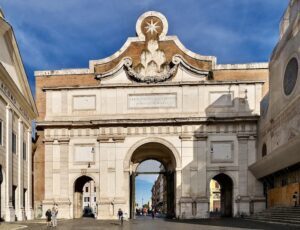
Porta del Popolo in Rome, Italy. Krzysztof Golik , CC BY-SA 4.0, Wikimedia Commons
_________________________
From the Aurelian Gate (now Porta San Pancrazio), one can still head northwest along the Via Aurelia. Built in the twilight of the Roman Republic, the road follows the Tyrrhenian coast through the port cities of Civitavecchia and Pisa, thence along the Ligurian coast all the way into Provincia Romana (Provence) in Gaul (France).
At the opposite end of Rome is the Porta San Sebastiano (nee Porta Appia) from which the Regina Viarum – the Appian Way – commences its journey south to Capua. Opened in 312 B.C. the road was named for the censor who proposed it, Appius Claudius. The well paved highway met with such popularity that it was later extended southeast to the port of Brundisium (Brindisi) in the heel of the Italian boot. This twin-turreted gate is the best preserved and most suggestive in the Aurelian circuit.
___________________________

Porta San Sebastiano. Ardeatino, CC BY-SA 4.0, Wikimedia Commons
___________________________
After the Saint Sebastian gate, perhaps the next finest entrance is the Gate of Saint Paul (originally Porta Ostiense because from here departs the old heavily trafficked road to Ostia). This gate also features twin lofty round towers and is totally intact as well. Abutting it and rising 120 feet into the air is the Pyramid of Cestius. While Paul did not see the gate named for him, since the Aurelian Walls were still two centuries into the future, the apostle undoubtedly cast his eyes on Cestius’ elaborate final resting place as he was being led out of the city to his martyrdom along the Via Ostiense one dark day in A.D. 67.
This is the gate that devout pilgrims have been taking, across the ages, to visit the venerable Basilica San Paolo Fuori le Mura (St. Paul’s Outside the Walls) about two miles down the road. Members of the Commission of Sacred Archeology, under the auspices of the Vatican, maintain that Paul’s remains lie in the crypt below the main altar. It was here at the Porta San Paolo, on 10 September 1943, that the Italian army troops aided by great numbers of civilians, partisans of the Resistenza, waged a fierce battle to block the Germans from entering the city, but in vain. Hitler’s forces prevailed and penetrated the walls, occupying and terrifying Rome until the Allied liberation on June 2, 1944.
___________________________
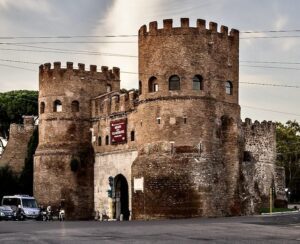
Porta San Paolo. Dietmar Rabich, CC BY-SA 4.0, Wikimedia Commons
___________________________
The Aurelian Walls added a rather simple opening as recently as 1574, the Gate of St. John, just a stone’s throw from the Basilica di San Giovanni, opening onto the Via Appia Nuova (the New Appian Way) which leads to the summer retreat of the popes in the tranquil town of Castel Gandolfo. The gate is rather plain. The inscription over the arch gives a brief biography of the gate:
GREGORIUS XIII PONT MAX
PUBLICAE VTILITATI ET
URBIS ORNAMENTO VIAM
CAPANAM CONSTRAVIT PORTAM
EXSTRUXIT MDLXXIIII PONT.III
“Gregory XIII Pontiff built this gate for the convenience of the public and as an ornament for the city, as well as the Country Road in 1574, the third year of his pontificate.”
The two side arches were opened in the early 1900’s to facilitate the flow of ever increasing traffic to and from the Castelli Romani (the dozen or so ancient hilltowns so popular with the Romans for weekend excursions).
Then there’s yet another gate favored by the pilgrims, the Porta San Lorenzo that takes them to the fourth century Basilica of Saint Laurence Outside the Walls, along the consular highway to Tibur (today’s Tivoli), the Via Tiburtina, the same name by which the gate was originally known. The great church was severely damaged accidentally by a stray Allied bomb on July 19,1943 when the Italian Army was still on the side of the Germans. The bomb was intended for the central rail yards nearby to cripple the enemy supply lines.
After the war, funds poured in from all over the world, especially from the U.S., to help with the massive restoration efforts. The magnet here for pilgrimages is the grave of the Deacon Laurence, martyred in the savage persecution under Emperor Valerian (253-259).
In A.D. 52 the Emperor Claudius had erected a majestic monumental arch to allow the aqueduct bearing his name to span two busy thoroughfares: Via Prenestina and Via Labicana. The arch was still standing in A.D. 271 but in the path that Emperor Aurelian had planned for his walls. So, as he did with the Pyramid of Cestius, he incorporated it into the fabric of his fortifications. The arch now served as an attractive gate which was given the name Porta Esquilina. In the late fourth century, the Romans took to calling it Porta Maggiore because of its proximity to the then recently built basilica named Santa Maria Maggiore, perched on the summit of the Esquiline.
___________________________
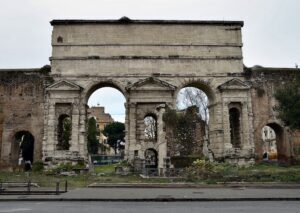
Porta Maggiore. Livioandronico2013, CC BY-SA 4.0, Wikimedia Commons
___________________________
Perhaps it’s worth noting at this point that the old Roman highways were customarily named for the officials who sponsored them, e.g. Via Appia for Appius Claudius; or for the towns that they led to. For example, the Via Ardeatina led to, and still leads to, the town of Ardea; the Via Nomentana to Nomentum; the Via Praenestina to Praeneste (now Palestrina) and, of course, the Via Ostiense to Ostia.
At the foot of the Caelian Hill we come upon the Porta Latina, a single arched gate accessing the Via Latina which runs through the various cities of old Latium (in our time, the region of Lazio). Just inside the portal are two noteworthy ecclesiastical structures: the small octagonal chapel of San Giovanni in Oleo, marking the spot where Domitian (81-96) had John the Evangelist boiled in oil. The second is the charming fourth century Romanesque church with the lilting name of San Giovanni alla Porta Latina, St. John at the Latin Gate.
____________________________
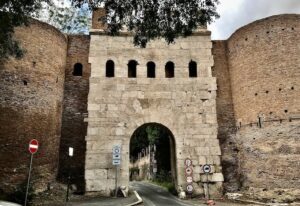
Porta Latina in Rome, Italy. Gustavo La Pizza, CC BY-SA 4.0, Wikimedia Commons
____________________________
The Porta Salaria, marked the starting point of Via Salaria, the old “salt road”, heading east 150 miles, all the way to the Adriatic coast where there were myriad salt-producing sites, causing heavy traffic to and from. This gateway had quite a checkered existence. On August 24 in the year 410, Alaric and his marauding Visigoths stormed through Porta Salaria on their way to plunder Rome. Left in rubble, it was later completely restored and strengthened. Many historians believe that this incursion signaled the beginning of the fall of the Roman Empire.
On September 20 in 1870, the gate suffered heavy bombardment by troops of Il Risorgimento, the Italian Revolution which brought an end to the Papal States. The gifted architect Virgiliio Vespignani was called upon to design a new entrance. This replacement survived barely a half-century when it was purposely torn down to allow a smoother flow of modern traffic out of and into the city.
Another one of the original gates, the Porta Ardeatina, from which the Ardeatine Road diverged, was walled up and a new, up-to-date replacement installed a few hundred meters further along the wall, but given the name of the original. The new Ardeatine Gate features four high and wide and graceful archways, providing easy access to the twentieth century speedway, Via Cristoforo Colombo that connects old Rome to the Mussolini era suburb of EUR.
The Aurelian Walls eventually were extended on the opposite bank of the river to defend the Trans Tiberim district (Trastevere). There was a gate just a few hundred yards beyond called the Porta Portuensis which opened onto the road by the same name, for it led to Trajan’s port at Fiumicino. The gate later underwent a name change in Italian to Porta Portese and is these days known for the large and lively Sunday flea market just outside of it.
____________________________
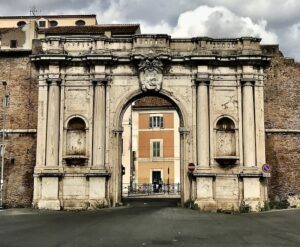
Porta Portese. Gustavo La Pizza, CC BY-SA 4.0, Wikimedia Commons
____________________________
For avid wall and gate watchers there is also the Muro Gianicolense (the Janiculum Wall) of Pope Urban VIII, dating from 1642, up on the hill named for Janus, god of beginnings and endings. This was the site of Garibaldi’s fierce confrontation in 1849 with Marshal Quindinot’s French forces who were helping Pope Pius IX to hold on to Rome, but they were unsuccessful.
……………………………………..
Lastly, let us tell of a most remarkable situation in Rome. Within this walled-in city lies a walled-in country … the Vatican. (Though merely 108 acres in size, Il Vaticano surely qualifies as a country – with its own borders, its own army, the Swiss Guards, its own population – about 1,000 – its own flag and anthem, its own postal system, its diplomatic relations with more than a hundred other nations including the United States, and its own head of state, the Pope, who is sufficiently regarded as such as to be from time to time invited to address the U.N. General Assembly.) In the ninth century this lilliputian city-state was girded with a mighty, clay-colored wall by order of Pope Leo IV, hence its name the Muro Leonina. There were originally five entrances but only two survived into the twentieth century: the Porta della Campana and the Porta Sant Anna, through which cardinals, bishops, and priests daily come and go, along with the permanent residents. In February of the Jubilee Year A.D. 2000, Pope John Paul II dedicated a new gate on the Viale Vaticano to accommodate the ever increasing multitudes of visitors to the Vatican Museums and the Sistine Chapel. In November of 2023 another gate was installed to afford more convenient access to the famous archeological site of the ancient Necropolis along the Via Triumphalis.
Ah, the gates of Rome. They – more than any of the myriad other monuments of Rome Eternal – have seen it all; from the Caesars to the Fascists, from the Vestal Virgins to the Popes, from the gladiators to the pilgrims, from the Model T to the Lamborghini. From a solitary small vineyard keeper driving his horse and wagon in from the campagna to sell his wines, to mighty armies rumbling through in trucks, jeeps, and tanks. From two lovers on a motor scooter to multitudes of tourists sardined into glass buses.
The Kingdom, the Republic, the Empire … all are gone. The Emperor Aurelian crossed the River Styx seventeen hundred years ago. But his walls and .. their gates … still survive.
As Browning noted: “Sooner or later everyone comes ‘round to Rome.”
He might well have added: “and through her gates!”
____________________________
Cover Image, Top Left: The Aurelian Walls at Porta Asinaria, Rome. MrPanyGoff, CC BY-SA 4.0, Wikimedia Commons
____________________________
Advertisement

EXPLORE THE ANCIENT ETRUSCANS IN PERSON!
Experience a unique, up-close-and-personal hike among ancient hilltop towns in central Italy. You will walk the sensational countryside of the regions of Umbria and Tuscany, soaking in important sites attesting to the advanced Etruscan civilization, forerunners of the ancient Romans; imposing architectural and cultural remains of Medieval Italy; local food and drink; and perhaps best of all — spectacular scenic views! Join us in this collaborative event for the trip of a lifetime!


